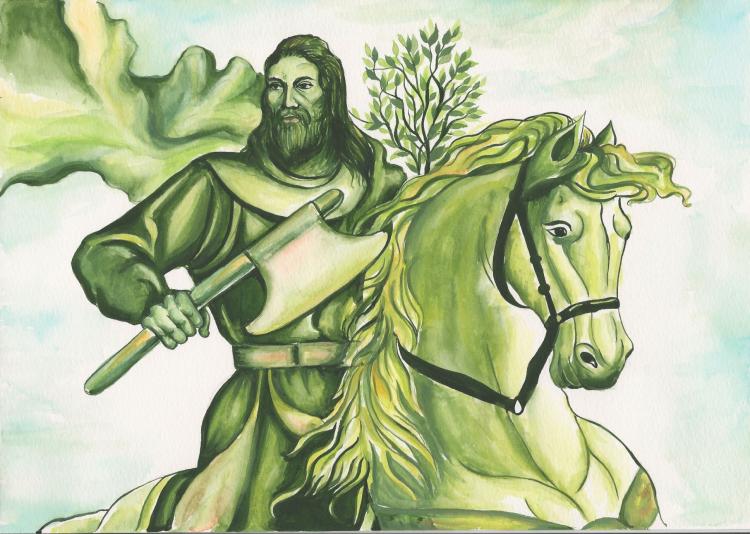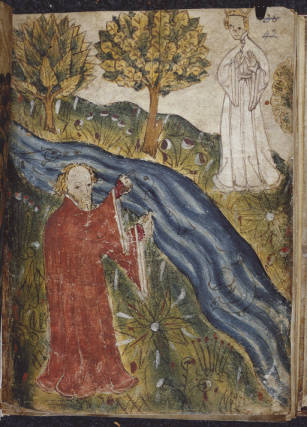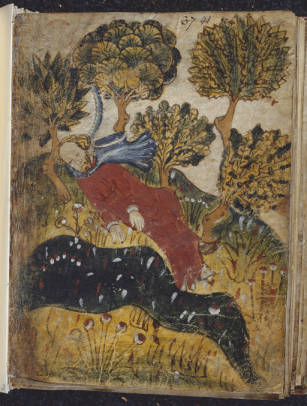[This post, part of an effort to merge our undergraduate and graduate blogs, was written in response to an essay prompt for Kathryn Kerby-Fulton's undergraduate course on "Chaucer's Biggest Rivals: The Alliterative Poets." It comes from the former "Medieval Undergraduate Research" website.]
In this post, I will translate and explore the description of Gawain’s entrance into Bertilak’s castle in “Sir Gawain and the Green Knight,” including how descriptions foreshadow future events of the poem and the nuances of the poet’s wordplay. Examples from this same selection will be used to illustrate my critique of three facets of Marie Boroff’s well-known translation of the poem, and further discuss the question of what constitutes a modern translation.
Lines 842-861 of “Sir Gawain and the Green Knight”
Gawayn glyȝt on þe gome þat godly hym gret,
And þuȝt hit a bolde burne þat þe burȝ aȝte,
A hoge haþel for þe nonez, and of hyghe eldee;
Brode, bryȝt, watz his berde, and al beuer-hwed,
Sturne, stif on þe stryþþe on stalworth schonkez,
Felle face as þe fyre, and fre of hys speche;
And wel hym semed, for soþe, as þe segge þuȝt,
To lede a lortschyp in lee of leudez ful gode.
Þe lorde hym charred to a chambre, and chefly cumaundez
To delyuer hym a leude, hym loȝly to serue;
And þere were boun at his bode burnez innoȝe,
Þat broȝt hym to a bryȝt boure, þer beddyng watz noble,
Of cortynes of clene sylk wyth cler golde hemmez,
And couertorez ful curious with comlych panez
Of bryȝt blaunner aboue, enbrawded bisydez,
Rudelez rennande on ropez, red golde ryngez,
Tapitez tyȝt to þe woȝe of tuly and tars,
And vnder fete, on þe flet, of folȝande sute.
Þer he watz dispoyled, wyth spechez of myerþe,
Þe burn of his bruny and of his bryȝt wedez.
My Translation
Gawain looked at the man that graciously greeted him,
And it seemed to him that a bold knight owned the castle,
A great knight indeed, and of a prime age;
Wide, beautiful was his beard, and all beaver-colored,
Powerful, firm was his stance on immovable legs,
His face as fierce as fire, and noble in his speech;
And it certainly suited him, indeed, as the knight seemed,
To hold a lordship in a castle full of good knights.
The lord took him to a room, and promptly commences,
To assign him a man to humbly serve him;
And there were ready at his bidding many men
That brought him to a beautiful bedroom, where the bedding was noble,
With bed-curtains of fine silk with lovely gold hems,
And exquisite coverlets with beautiful edging,
Of beautiful fur around it, embroidered at the sides,
Curtains sliding on ropes, guided by gold rings,
Tapestries hung on the wall made of red silk and silk of Tharsia,
And underfoot, on the floor, rugs of a similar kind,
There he was stripped, with conversations of merriment,
The man, of his mail-chain and of his shining armour.
Poetic analysis
To begin, the imagery used to describe Bertilak loosely associates him with the Green Knight and also panders to Gawain’s idealistic notion of knighthood. Firstly, the poet describes Bertilak in terms of features that have been associated with the Green Knight in Fitt I: an impressive, distinctively colored beard (“brode,” and “beuer-hwed,” line 845), and his “stalworth schonkez,” (line 846). By implicitly making these comparisons, the poet is hinting at the revelation that Bertilak is the Green Knight. He is also toying with the theme of deception by magic that weaves in and out of the poem.
Further, the imagery of the castle reflects the poet’s familiarity with courtly life. He goes into detail of what would be at a castle, but the descriptions of the bed-curtains and tapestries are not described in terms of colors or specific designs, but rather as “bryȝt,” or “clene,” (lines 854, 855, 857). “Bryȝt” can mean bright, shining, or beautiful. The one color that is invoked is “golde,” (line 854). Instead of being able to picture exactly what these fabrics look like, the reader is given heavenly or magical imagery of pure light and shininess to imagine. Thus, the effect is again a hint of what the castle will turn out to be: a disguised destination, a place of magic, and ultimately, with the temptation scenes, a distraction for Gawain from his quest for perfect knighthood.
Another crucial poetic element to this selection is its wordplay. In lines 850 and 851, Bertilak leads Gawain to a “chambre” and “cumaundez/To delyuer hym a leude.” In this instance, “cumaundez” means to “commence to assign him a man,” but it also has the connotation of “to command,” suggesting that Bertilak is controlling Gawain without him even realizing it. Another example comes in line 861, when the servants strip Gawain of his “bruny and of his bryȝt wedez.” “Wedez” can mean “clothes” or “armour.” Thus, through the mere act of undressing him, the servants are actually making him vulnerable, removing the veneer of his “knighthood” on which he so heavily relies to reveal who his true, flesh and blood moral character is underneath.
In this selection, the words that are obviously missing from lines imply a deeper level of meaning as well. In line 847, “Felle face as þe fyre,” does not tell the reader to whom the poet is referring. He should be referring to Bertilak’s face, but as he has not yet revealed himself as the Green Knight, that attribution is noticeably absent. Another example of an omission is in line 859. The phrase “on þe flet, of folȝande sute” is missing the word for what is on the floor: tapestries or rugs. I like to think of this as a foreshadowing for the surprises in store for Gawain: having the rug pulled out beneath him, so to speak.
Finally, these elements of imagery, wordplay, and omission, in addition to the actions of Bertilak all support the larger “too good to be true” theme of the poem. All of the games Gawain engages in (the beheading game, the exchange of winnings, etc.) seem to be easy at face value. However, the elements of magic in addition to Gawain’s debilitating perfectionism are always working against him to turn the games on their heads.
Critique of Marie Boroff
I will use Boroff’s translation of the same passage to illustrate her treatment of the original alliteration, use of archaic language, and creative license in terms of word choice, omissions, and additions.
Boroff translation
Gawain gazed on the host that greeted him there,
And a lusty fellow he looked, the lord of that place:
A man of massive mold, and of middle age;
Broad, bright was his beard, of a beaver’s hue,
Strong, steady his stance, upon stalwart shanks,
His face fierce as fire, fair spoken withal,
And well suited he seemed in Sir Gawain’s sight
To be a master of men in a mighty keep.
They pass into a parlor, where promptly the host
Has a servant assigned him to see to his needs,
And there came upon his call many courteous folk
That brought him to a bower where bedding was noble,
With heavy silk hangings hemmed in all gold,
Coverlets and counterpanes curiously wrought,
A canopy over the couch, clad in fur,
Curtains running on cords, caught to gold rings,
Woven rugs on the walls of eastern work,
And the floor, under foot, well furnished with the same.
With light talk and laughter they loosed from him then
His war dress of weight and his worthy clothes.
Alliteration
The most prominent of these qualities in the selection is Boroff’s treatment of alliteration. While it supports the general use of alliteration in the poem, it does not adhere to its specific function within lines. In line 843, Boroff maintains a three-part alliteration in the line, but it is “L” alliteration of “lusty,” “looked,” and “lord” as opposed to “B” alliteration of “bolde,” “burne,” and “burȝ.” This raises the question of whether including any alliteration in a modern translation serves an equivalent meaning to the original alliteration. It will also inform the reader of the broader question of the translator’s definition of and purpose of a modern translation.
In this example, changing the emphasized letter changes the reading of the line and of the selection as a whole. In a phonetic sense, the “B” sound at the beginning of a word is more forceful than “L.” By omitting the “B” sound, Boroff reduces the “force” of the man that is characterized in the poetic device of alliteration.
Furthermore, this “force” of Bertilak is illustrated in the strength of the words selected for the original alliteration. Definitions of the Middle English word “bolde” include “bold,” “daring”, and “valiant.” The next alliterative word is “burne,” which can mean “man” or “knight.” Because the man has not done anything particularly “valiant” yet, the reader can infer that Gawain feels there is something bold or heroic about him because the poet is also associating him with the knight. Finally, “burȝ,” is further associated with the power of owning a castle, being a knight, etc. The words used in the poet’s alliteration build on each other to characterize Bertilak.
Thus, alliteration is stronger when the sound supports the character that the poet is creating throughout the poem. In contrast, Boroff’s line combines the weak “L” sound, the odd characterization of Bertilak as “lusty,” and the passivity of “looked” versus the power associated with “burȝ” in the original text. These words do not support each other; as a result, the translation weakens the device of alliteration.

Archaic language
Boroff’s use of non-modern language evokes the question of purpose in a modern translation. Is the main purpose to provide the most accurate translation of the original text or to capture the spirit of the text and make it as easy as possible for a modern audience to understand?
In general, Boroff’s translation leans toward the latter. This is not necessarily a wrong interpretation, but it makes occasional archaic phrases stand out all the more. For example, line 846 refers to Bertilak’s “stalwart shanks” in the Boroff translation. This is the closest modern word to word translation of the original, “stalworth schonkez.” The word “shanks” also shows up earlier in Boroff’s translation in line 431 (“stiff shanks”). However, the word “shanks” is more appropriate for a cut of meat than a human set of legs to a modern reader. It is a textbook example of the closest translation to a Middle English word not capturing the spirit of the text in this day.
If Boroff is indeed trying to make Gawain approachable to the modern reader, one more question follows: Is it possible to make a truly modern translation of a story with archaic settings, characters, and plot lines? One choice Boroff made in the selection is the phrase “mighty keep” (line 849). Not only is the phrase archaic, it also deviates from the poet’s original meaning. This phrase means “charge” or “control,” rather than the original text’s “lee” which means “shelter” or “castle.” Castle would have been much easier for a modern reader to understand and closer to the text’s original meaning. In this case, “charge” does have a more universal meaning, but if one undermines the castles in Gawain, what are next? The knights? The poem needs to maintain its identity as an Arthurian tale, so the castles should stay.
Creative license
At times, Boroff’s creative attempts to modernize the piece endanger the continuity of the story. For example, she refers to the “parlor” that Bertilak and Gawain “pass into” (line 850). According to the Oxford English Dictionary, the Anglo-Norman French origins of the word “parlur” meant simply “place for speaking” to Middle English speakers. The original text uses “chambre,” so one commends Boroff for using a French word and maintaining all of those associations. However, parlors have an entirely different connotation to a modern reader, and is not consistent with a tale about knights and castles.
Seeing as the poet did it himself at times, it seems appropriate to analyze where Boroff omits words entirely in her translation. In the selection, she omits “godly,” meaning “courteously” or “graciously” (line 842). This contributes to her deviating characterization of Bertilak, as previously discussed. If Gawain does not see him as a gracious host, he loses the associations of knightliness and goodness, and also loses his personal connection to this “bolde” or “heroic” knight, Bertilak.
Oddly enough, an example of Boroff adding words back in leads the reader to line 852, in which Boroff refers to the “many courteous folk” who do Bertilak’s bidding. The original texts only says there are “burnez innoȝe,” or “many men.” Ironically, she adds back in the very word she omitted ten lines ago! It seems strange that she would attribute courtesy to the servants of Bertilak’s castle, who hold little role in the poem, instead of to Bertilak. In all of these small tweaks, Boroff is essentially recasting Bertilak as the villain to Gawain as the hero, which is inconsistent with Gawain’s true admiration for the man.
In conclusion, Boroff’s treatment of the original alliteration, omissions, and additions re-characterize a main character in Gawain as a “lusty” villain. Her use of archaic language and creative license in terms of more modern word choices make her modern translation less consistent and hard to categorize as a purely text-based, or modern read. Only the nuances of associative imagery, shiny distractions for Gawain and the reader, and the wordplay of the original text can fully capture the “burne” that is Bertilak and his role in Gawain’s journey.
Claire McCarthy
University of Notre Dame



